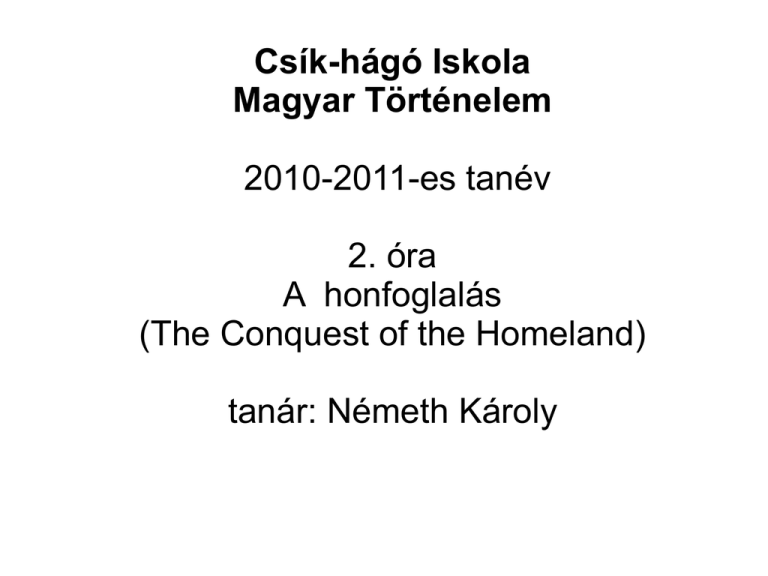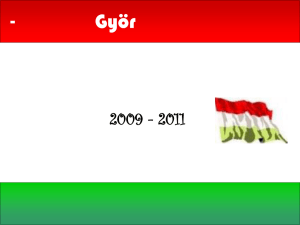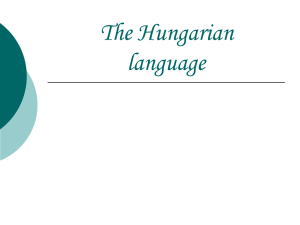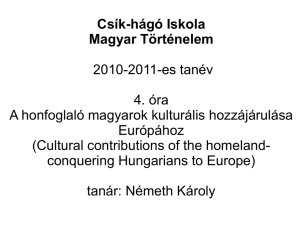Árpád vezér és a honfoglaló magyarok
advertisement

Csík-hágó Iskola Magyar Történelem 2010-2011-es tanév 2. óra A honfoglalás (The Conquest of the Homeland) tanár: Németh Károly Felhasznált anyagok az internetről: http://hu.wikipedia.org/wiki/Magyar_őstörténet http://en.wikipedia.org/wiki/Hungarian_prehistory http://ww3.szentes.hu/honfoglalas/honfog/honfog.htm http://honfoglalas.lap.hu/ Isten, áldd meg a magyart Jó kedvvel, bőséggel, Nyújts feléje védő kart, Ha küzd ellenséggel; Bal sors akit régen tép, Hozz rá víg esztendőt, Megbűnhődte már e nép A múltat s jövendőt! (“Himnusz”, Kölcsey Ferenc verse (1823)) O Lord, bless the Hungarian nation With your grace and bounty Extend over it your guarding arm During strife with its enemies Long torn by ill fate Bring upon it a time of relief This nation has suffered for all sins Of the past and of the future! (“Hymn”, by Ferenc Kölcsey (1823)) Ismétlés: a magyarság vándorlása a Közép-Ázsiából Kárpát-medencéig Recapitulation: migration of the Hungarians from Middle-Asia to the Karpatian Basin. A honfoglalás időbeli lezajlása 893 és 907 között. Major steps of the Hungarian homeland-conquest between 893 and 907 AD. A honfoglaló magyarság hét törzsének neve: / The seven tribes of the conquering Hungarians: Tarján, Jenő, Kér, Keszi, Nyék, Megyer, Kürt-Gyarmat. A hét törzs vezéreinek neve / Names of the seven Chieftains of the Hungarian tribes: Álmos, Előd, Ond, Kond, Tas, Huba, Töhötöm. További szövetséges népcsoportok akik részt vettek a honfoglalásban: Székelyek: eredetük bizonytalan, lehet hun, avar vagy magyar is. A három nép rokonságát állítja a magyar hagyomány. People who may have Hunnic, Avar or Hungarian origin. According to Hungarian traditions these 3 nations were Relatives of each other. Kabarok: a kazárok közül Etelközben kiszakadt népcsoport. A renegade tribe/group of the Kazars that allied with the Hungarians. A hét magyar vezér szövetségét vérszerződés alkalmával erősítették meg (Székely Bertalan festménye 1896-97-ből). A vérszerződés még Etelközben történt. The alliance of the Hungarian tribes was made binding by the covenant of blood (painting by Bertalan Székely, from 1896-97). The covenant of blood ceremony took place in Etelköz. Budapest (Magyarország fővárosa), Hősök tere. A hét vezér szobra a magyar történelmi hősök emlékoszlopa körül. Budapest (the capital of Hungary), Heros' Square. The statues of the seven Hungarian Chieftains of the Homeland-Conquest period, around the memorial column of the Hungarian heroes of the history. Képek a hősök teréről / Heros' Square pictures Az Országház épülete Budapesten ( 1885 és 1904 között épült) The House of the Parliament, the “House of the Country” (built from 1885 to 1904). Árpád vezér és a honfoglaló magyarok (Munkácsi Mihály magyar festőművész “Honfoglalás” című képe, 1893-ban készült.) Mihály Munkácsy: Settlement of the Magyars in Hungary (piece of painting, from 1893), In the center: Árpád, the military leader of the conquering Hungarians. Az egész kép. / The full picture. A kalandozások kora, körülbelül 900-970 között . The age of Hungarian military explorations and raids of Europe, approximately 900-970. A 900-as évek elején született modenai latin nyelvű himnusz részlete / Part of a latin-language Hymn from Modena (North Italy) from the early 900 : „ab Ungerorum nos defendas iaculis” – vagyis: „védj meg (Uram) minket a magyarok nyilaitól.”. / meaning: Lord, save us from the arrows of the Hungarians. Visszafelé nyilazó magyar lovas egy észak-olaszországi templom (Aquileia-ban) Falfestményén, a 900-as évekből. Hungarian rider shooting arrows backwards as depicted on a mural painting of a North-Italian church in Aquileia, from the years of 900 AD. Magyarország a 11. században (1000 és 1100 között). Hungary in the 11th century (between 1000 and 1100 AD). Hazádnak rendületlenűl Légy híve, oh magyar; Bölcsőd az s majdan sírod is, Mely ápol s eltakar. (Vörösmarty Mihály “Szózat” című verséből (1836)) To your homeland without fail Be faithful, O Hungarian! It is your cradle and will your grave be Which nurses, and will bury you. (from “Szózat” (in English “Summons”) by Mihály Vörösmarty (1836))


